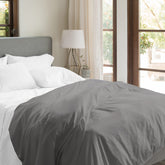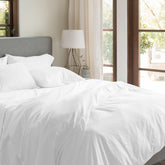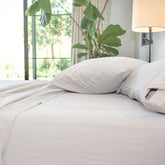We spend one third of our lives asleep, yet the reasons behind this remain a mystery. Not the passive state many people once considered it to be, sleep is now known to be a highly active process during which we process the day’s events and our energy is restored. And yet, despite its importance to our physical and mental wellbeing, research into the science of sleep has been – well, sleepy! One thing we do know for sure is that a good sleep environment is essential to getting a restful sleep. Improving your sleep environment can have lasting benefits in many areas of your life, including improving your mental focus and work performance.

How to Create the Perfect Sleep Environment
Since we spend such a large portion of our lives under the covers, it’s important to make sure that our sleep environment is as healthy as possible. Here are some of my top tips for doing just that!

Make Your Bed an Oasis. Creating the perfect sleep environment starts with the basics: your mattress, pillows, blankets, and sheets. Comfortable, breathable bedding is essential for a good night's sleep. Make sure you select a mattress that provides the right amount of support. Pillows should be thick enough to support your neck and head, while blankets should be warm enough to keep you cozy without being too heavy. Keep an extra blanket at the foot of the bed. During colder months this will come in handy when you want to curl up for an afternoon nap. Add a touch of luxury in the form of petal soft sheets or cozy pillows and you may find yourself crawling into bed earlier than planned - never a bad idea!

Your Bedroom Should Be Your Sanctuary. After a long day, you should be able to retreat to a place of tranquility and calm. Make sure to keep it tidy and clutter-free. Our minds often process information while we are sleeping, and a messy, cluttered room can be a distraction. Make it a habit to put away items that you don’t need, and consider investing in a few organizational items to keep your room looking neat and tidy. You should also make your bed every day to set yourself up for success.

Surround Yourself with Scents that Relax You. Classic scents like lavender have been shown to reduce blood pressure and decrease your heart rate. Place a few fresh sprigs into a small vase beside your bed or use a few drops of lavender essential oil on a scent free dryer sheet. Calming scents, used frequently, will trigger your body, letting you know it's time for bed.

Keep Your Bedroom Cool and Dark. Once you have your mattress and bedding set up, you can go a step further and consider other elements that can affect your sleep. Lighting is an important factor, as bright lights can make it difficult to fall asleep. Consider adding blackout lining to your curtains to keep the light out for optimal relaxation. Temperature is another important factor – in fact, one study showed that insomniacs who wore cooling caps that helped reduce body temperature were able to sleep as soundly and for the same amount of time as those without sleep disorders. A room that is too hot or too cold can affect sleep quality and even reduce the quality of REM sleep. Most experts recommend a bedroom temperature of 62-68 degrees with comfortably warm bedding and socks. Find the temperature that is most comfortable for you and make sure to adjust your thermostat accordingly.

Power Down Before Bed. The light from computer screens, televisions, and phones can hinder the production of melatonin, which means your body isn't preparing the hormones it needs to enter the sleep phase. Specifically, it is the blue wavelength of light that seems to decrease melatonin production. Develop a ‘power down’ routine where you shut off all electronics an hour or two before sleep. Additionally, working late at night can keep your mind racing and your stress levels high, which also prevents the body from calming down for sleep. Turn off the screens and read a book instead. It's the perfect way to learn something useful and power down before bed.

Use Muted Colors. Your room should be calm and peaceful. Choosing muted colors in the blue, gray and green family will instantly relax you.
Soak Up the Sun. Vitamin D plays an enormous factor in regulating your body's Circadian rhythm. Aim for at least 30 minutes of sun exposure each day.

Use Gentle Relaxation Techniques. Find outlets to reduce your stress and you'll often find that better slumber comes as a result. Proven methods include daily journaling, deep breathing exercises, meditation, exercise, and keeping a gratitude journal. Making this a nightly ritual will clue your body in to the fact that it's time for bed.

Avoid Caffeine. Eliminate caffeine from your diet if you're having trouble falling asleep. If you can't go without your morning cup of coffee, then a good rule of thumb to keep in mind is ‘no coffee after noon’. This gives caffeine enough time to wear off before bedtime.

Creating the perfect sleep environment can be a challenge, but it’s worth the effort. A good night’s sleep can have a positive impact on your focus, physical health, and work performance, so make sure to create an environment that will promote restful sleep.






